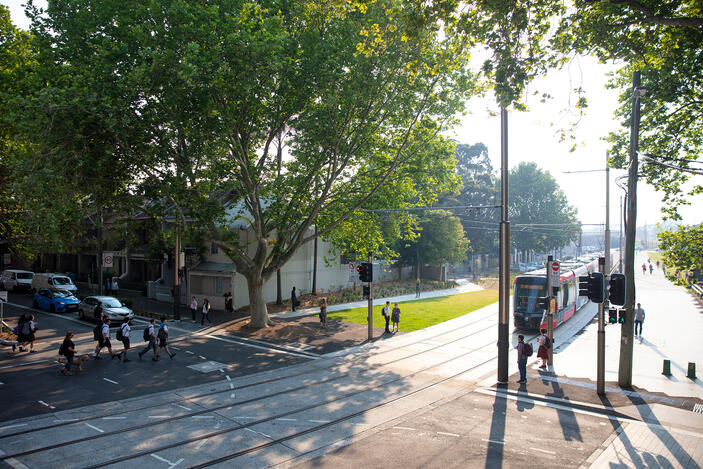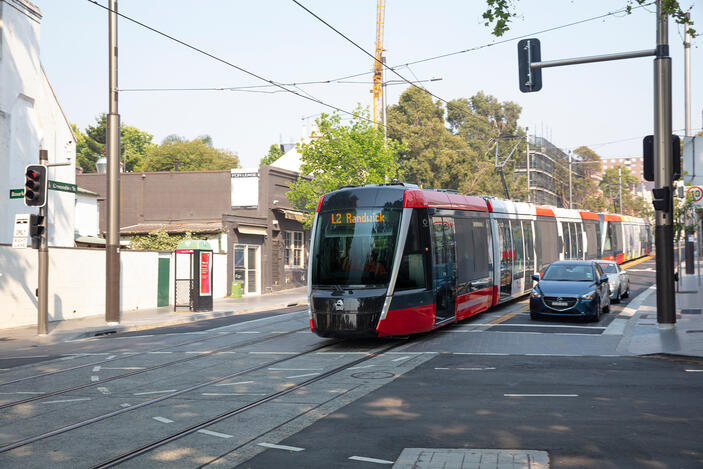Light rail safety
Whether you're walking, cycling, driving or catching public transport, it's important we all play our part to stay safe around light rail.
Stay alert and be aware of your surroundings. Always use designated crossings and avoid distractions like mobile phones.
If you’re travelling on-board light rail, don't overcrowd the platform and wait for people to get off the light rail before you board.
Safety around light rail

- Always use designated crossings.
- Look left and right, check twice for trams.
- Avoid slips, trips and falls. Watch your step and don't rush for the light rail.
- Ditch distractions such as mobile phones.
- Stay alert to your surroundings.
- Step over the tracks as they can be slippery, especially when wet.
- For prams and wheelchairs, cross straight over the tracks to avoid wheels getting caught.
- When changing platforms, exit towards the end of the platform and use the designated crossings.
- Never cross directly in front or behind a light rail vehicle as other drivers may not be able to see you.

- Ride straight over the tracks to avoid your wheels getting caught. If you can’t ride straight over the tracks, it’s safer to get off and cross at a designated crossing.
- Don't ride along the tracks.
- Tracks can be slippery when wet, it’s always safer to dismount.
- Use the shared pathways where possible.

- Don't drive in the tramway.
- Never queue across intersections.
- Always follow traffic signals and signs.
- Never turn in front of a tram.
- Don’t stop or park within the tram lane (even when you can’t see a tram).

- Look for overhead wire height restrictions, a general height restriction of 4.6 metres is in place.
- Never queue across intersections.
- Follow traffic signals and signs.
- Never turn in front of a tram.
- Be aware that road conditions have changed.
Safety on-board light rail
If you have accessibility requirements, read through the accessible travel information when planning your trip.
There are also guidelines for travelling with prams and young children on public transport.
- Tap on and tap off at the Opal reader on the platform, before you board and at the end of your trip.
- Keep the pathway clear around you at the stop to allow others to walk past safely.
- When waiting on the platform, stand well back from the track behind the yellow line.
- Wait until the light rail has come to a complete stop before attempting to board.
- Never touch a moving vehicle.
- If you have dropped something on the track, do not collect it yourself. Use the Emergency Help Point on the platform to receive assistance.
- Be cautious when crossing the tracks. Never cross if a vehicle is approaching. Follow the guidelines for level crossing safety.
- Avoid slips, trips and falls. Don’t rush for the light rail.
- Stand back to allow passengers to get off the light rail before you get on.
- If travelling with a pram and young children, hold their hands when boarding to ensure they are not left behind.
- On the L1 Inner West light rail, do not board at the rear and front single doors if you have a pram, bike or other large item. Please note that bikes are not allowed on Newcastle light rail.
- Mind the gap and be careful getting on and off the light rail.
- Take a seat if one is available or use a feet-apart strong stance to stand strong and always hold on to a handrail or seat back for a safe departure and journey.
- If you are concerned about your safety or the safety of others, or in an emergency, please:
- Move away from danger if possible
- Alert the driver by using the Emergency Help Point on board
- Listen for instructions from the driver
All light rail vehicles and platforms have CCTV cameras and Emergency Help Points installed for the protection of passengers and staff.
Police and Authorised Officers patrol light rail vehicles and stops.
If you need immediate help, contact the police on 000 or use the Emergency Help Points.
If you see something, say something
By reporting security incidents, unattended items or suspicious behaviour, you can help us respond to any immediate problems and make it safer for everyone.
Call 000 or contact the National Security Hotline on 1800 123 400.
On all light rail vehicles and at each light rail stop, Emergency Help Points are available and CCTV cameras are installed.
Some CCTV cameras are only used to monitor and do not record footage. If footage has been recorded, you can request access to this footage.
If you press an Emergency Help Point at any light rail stop, you're visible on live CCTV and can get assistance from a trained operator.
If you press an Emergency Help Point on board the light rail, the driver will assist you and contact the control centre.
A security control centre operates 24 hours a day, 7 days a week, with communication links to transport officers, police and emergency services.
If you are not feeling well or you see someone who looks like they need help, use the Emergency Help Point at stops and on board the light rail to notify staff and they will arrange medical assistance.
Please do not board the light rail if you're not feeling well at the stop. We will be able to get help to you much quicker at the light rail stop.
In an emergency, call 000.
Light rail safety flyer
Working on or near the light rail corridor
Hazard zones have been established along the light rail corridor to help identify areas of increased risk including electrical hazards and light rail movements.
All works in a hazard zone require approval and an approved Permit to Work before proceeding.
If you require a permit to work along the L2 line (between Circular Quay and Randwick) or L3 line (from Kingsford via Kensington to Circular Quay), you can access permits on the Transdev Work Access Permit page.
If you require a permit to work along or near the L4 Westmead & Carlingford line (Parramatta Light Rail), you can access permits on the Greater River City Light Rail page.